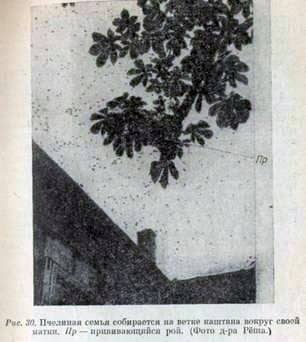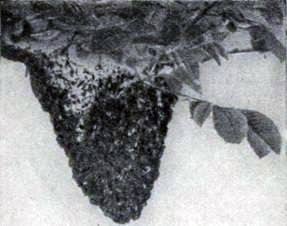
Spring is the time of flowering, the abundance of food and the most intensive brood rearing. With the rapidity with which the larva develops, the zealous egg laying by the uterus leads to a rapid increase in the number of bees in the family and, as a result, to a rapid increase in the family, but not to a direct increase in the number of families in the apiary, since each family of bees with the uterus is an isolated ” state “in which the bees that grow from brood only replenish the number of its” citizens “.
However, bee colonies must also multiply. After all, often one of the families perishes from illness, a hunger strike after a bad summer or because of some other accident, and if there were no new families, soon there would be no bees left.
A new family needs a new uterus; Only if the emergence of it is ensured, the family as such can multiply, and this happens by “swarming” the bees.
Preparation is conducted in complete silence. As a rule, in May worker bees lay several queen cells and grow them in special feeding of young queens. In most cases, they would have had enough of one uterus, but with it a misfortune can occur. It is not difficult to destroy several superfluous queens of bees, but it is absolutely impossible at the right time to get one missing. Nature is not peculiar to sentimentality, so the family is grown with half a dozen or more queens, most of which are doomed to death in advance.
About a week before the first young uterus should hatch from its cell, the family rummages. Apparently, in this case the initiative again comes from worker bees. Already a few days before their activities are somewhat reduced. In a strong family, bees are sitting in a dense cluster in front of the door of their home. Suddenly, all of them come to excitement, rush into the hive, cuddle to honeycombs and fill honey honey crabs. Approximately half of all the bees of the family fly out of the hive. With “satchels” full of honey, which they take with them as food in an unknown way-road, the bees rush to the tap and rise up in a disorderly, violent whirlwind. They swirl, fleeting, at each other. In the air – a whole cloud of bees. Together with them, the uterus and the old uterus leave.


Fig. 31. Roy gathered on a branch around the uterus and formed a “bunch of bunches.”
At first their way is not far off. The bee cloud gathers near a tree branch or some other object and is located on it with a dense swarm “bunch” around the uterus. Now the moment comes when a quick beekeeper can easily transfer a swarm into an empty hive and consider it his own. A beekeeper who is too late can miss the swarm. After all, while the swarm in inactivity hangs on the branch, its quarters (intelligence bees) are already searching for a hollow tree suitable for a swarm or an empty beehive, which is often in a remote apiary. Returning, they lead the swarm in motion and lift it into the air. The swarm of bunches crumbles, and again the bees, like a cloud, move in the sky, heading for their new home, where their intelligence bees lead. As if on purpose, this often happens at the exact moment,
The bees remaining in the old hive now do not have the head of their kingdom. However, after a few days, the first young uterus hatchs. She does not immediately begin her maternal duties. The womb that has just emerged from the queen is virgin (barren), and before she can begin oviposition, she has to make a mating flight. The uterus is not inseminated inside the bee hive. In most cases, during the first week after leaving the mother liquor, it flies out of the hive to freedom and mates in the air with one or more drone.
Departure can be repeated in the following days. After that, she becomes a sedate mother of a bee; family, who never leaves his house – unless next year, when she will be overthrown from the throne by a young womb and hurry to the tap with a new swarm. So this process takes place, if the family releases only one swarm. In this case, after the birth of the first young womb, worker bees destroy all excess queen cells along with their living contents. But a young womb with a part of the bees can fly out and with a second swarm.
In this case, after the first uterus leaves, the working bees, first of all, preserve the life of other young queens. Those do not leave their queen cells, because the free-walking uterus will not tolerate the presence of other queens in the hive and will immediately attack them. Sitting in the queen cells, the uterus just pops the proboscis through small holes in its queen cells and receives food from worker bees. In the hive at this time, sounds a kind of duet. Walking about the honeycomb, the uterus sounds “tu-chu” (“bales”), and the uterus in the queen cells makes themselves heard by other sounds: a muffled “quasqua” is heard from their dungeons.
The beekeeper says that the croaking uterus is asking for freedom, but as long as the “barking” is heard in response, they are careful not to leave their shelters. Bees can not “hear” like us, and it is very doubtful that they could notice the difference between “baling” and “croaking”. But thanks to a thinly developed sense of touch, they can very well perceive the sounds being given in the immediate vicinity of them. If artificial sounds are reproduced artificially, one can talk to one of the queen bees, forming with it a “duet” of questions and answers. Probably, odor is also involved in keeping young queens from premature withdrawal from queen cells. In any case, while in the queen cells, the uterus feels when their rival flies with a new swarm. After that, they are selected from their cradles.
Sometimes swarms go more and accordingly more queens enter their rights. On the other hand, in bad weather and poor nutrition, swarming may not be at all.
Что пьют пчелы. Что вредно для пчел.
The bee family and its composition